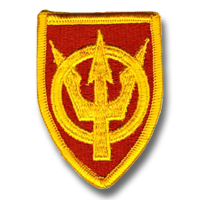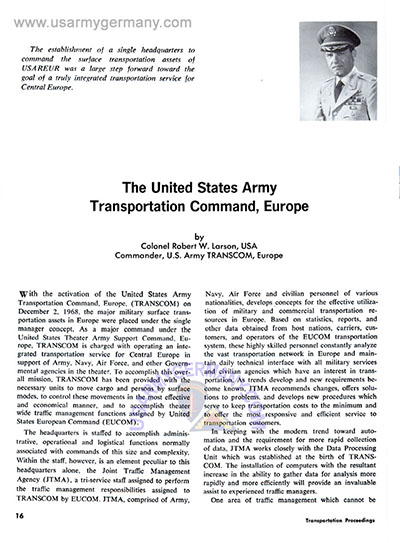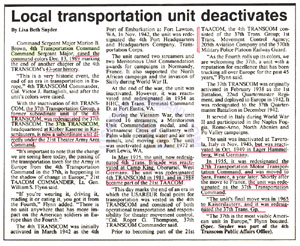| If you do
NOT see the Table of Contents frame to the left of this page, then
Click here to open 'USArmyGermany' frameset |
||||||||||||||||||||||||||||||||||||||||||||||||||||||||||||||||||||||||||||||||||||||||||||||||||||||
4th Transportation Command |
||||||||||||||||||||||||||||||||||||||||||||||||||||||||||||||||||||||||||||||||||||||||||||||||||||||
|
|
||||||||||||||||||||||||||||||||||||||||||||||||||||||||||||||||||||||||||||||||||||||||||||||||||||||
|
||||||||||||||||||||||||||||||||||||||||||||||||||||||||||||||||||||||||||||||||||||||||||||||||||||||
|
|
||||||||||||||||||||||||||||||||||||||||||||||||||||||||||||||||||||||||||||||||||||||||||||||||||||||
| COMZEUR Transportation Command History | ||||||||||||||||||||||||||||||||||||||||||||||||||||||||||||||||||||||||||||||||||||||||||||||||||||||
| 1965 - 1968 | ||||||||||||||||||||||||||||||||||||||||||||||||||||||||||||||||||||||||||||||||||||||||||||||||||||||
| (Source: STARS & STRIPES, November 23, 1965) | ||||||||||||||||||||||||||||||||||||||||||||||||||||||||||||||||||||||||||||||||||||||||||||||||||||||
The Com Z Transportation Command recently assumed operational and movement control previously handled by the US Army Traffic Management Control Center at Frankfurt. With this recent action, the organizational structure of the Trans Comd has basically been completed. The command now controls all types of transportation units: port, military highway and movement control, within its logistic support structure. -- serving as a point of contact for all users of transportation for whom Com Z has logistic support responsibility; |
||||||||||||||||||||||||||||||||||||||||||||||||||||||||||||||||||||||||||||||||||||||||||||||||||||||
| Transportation Command History | ||||||||||||||||||||||||||||||||||||||||||||||||||||||||||||||||||||||||||||||||||||||||||||||||||||||
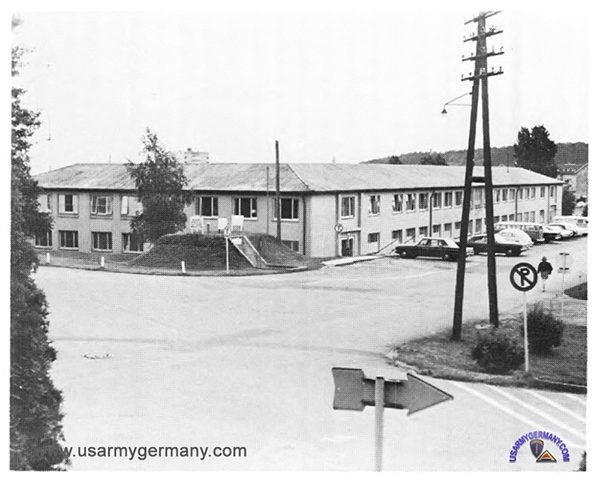 Headquarters building, USATRANSCOMEUR, Camp King, Oberursel, 1969 |
||||||||||||||||||||||||||||||||||||||||||||||||||||||||||||||||||||||||||||||||||||||||||||||||||||||
| 1965 - 1980 | ||||||||||||||||||||||||||||||||||||||||||||||||||||||||||||||||||||||||||||||||||||||||||||||||||||||
| (Source: Transportation Command, COMZ. 29 February 1980) | ||||||||||||||||||||||||||||||||||||||||||||||||||||||||||||||||||||||||||||||||||||||||||||||||||||||
| 1. Genesis. Establishment of TRANSCOM, COMZ. | ||||||||||||||||||||||||||||||||||||||||||||||||||||||||||||||||||||||||||||||||||||||||||||||||||||||
| The Transportation Command has been known in Europe since February 1 1965 when it was provisionally formed from the Transportation Division of HQ, COMZ. The structure of the COMZEUR Transportation Command included the 37th Transportation Group, headquartered at SAMEC, France, at that time and the Movements Control Center at Frankfurt as subordinate elements. It exercised operational control of port operations at the Bremerhaven, Benelux, U.K., Rhine River and Lisbon Terminals. Also assigned were the 2nd Aviation Co and the 22nd and 56th Aviation Detachments. The Transportation Command headquarters was located at Harbord Barracks, close to Orleans, France. | ||||||||||||||||||||||||||||||||||||||||||||||||||||||||||||||||||||||||||||||||||||||||||||||||||||||
| 2. Exodus (FRELOC). | ||||||||||||||||||||||||||||||||||||||||||||||||||||||||||||||||||||||||||||||||||||||||||||||||||||||
| The relocation of the US Forces out of France, known as FRELOC, in 1966-67 stationed the HQ, TRANSCOM at Azbill Barracks, Rüsselsheim, Germany, in February 1967. Action was directed by the CG, COMZ on 17 July 1967 to abolish the HQ, TRANSCOM and establish a Director of Transportation at HQ, COMZ, Worms, Germany. HQ, USAREUR General Order Number 53, dated 27 February 1968, formally inactivated the Headquarters Transportation Command, effective 5 February 1968. | ||||||||||||||||||||||||||||||||||||||||||||||||||||||||||||||||||||||||||||||||||||||||||||||||||||||
| 3. Reestablishment. | ||||||||||||||||||||||||||||||||||||||||||||||||||||||||||||||||||||||||||||||||||||||||||||||||||||||
| In that same month, February 1968, the Director of Transportation, HQ, COMZ, COL Robert W. Larson, was directed by the CG, COMZ to prepare a paper on the early reestablishment of the Transportation Command. The mission, organization, staffing and equipment for the new command were based on the TASTA-70 (FM 54-8 (Test)) and the USAREUR OPLAN 4405-CCLS-70. The reestablished Transportation Command, COMZ, was formed from the US Army Traffic Management Agency, Central Europe; the headquarters of the 107th (Transportation) Brigade; the 37th Transportation Group; the US Army Terminal Command, Central Europe, and was authorized an ADP unit from USAREUR assets. Five spaces from USEUCOM were further allotted, but not included in the TRANSCOM MTA. These five spaces were filled by Air Force and Navy personnel, who occupied positions in the command headquarters. Upon decision of the CG, COMZ, the US Army Reception Group, Europe was moved to Camp King (Oberursel) by COMZ General Order Number 254, December 1968. This unit was formerly a DCSOPS Activity, administered by the AG of COMZ, with its two detachments, "A" and "B", located in Munich and Rüsselsheim, Germany, respectively. | ||||||||||||||||||||||||||||||||||||||||||||||||||||||||||||||||||||||||||||||||||||||||||||||||||||||
| 4. Camp King, Oberursel, Germany. | ||||||||||||||||||||||||||||||||||||||||||||||||||||||||||||||||||||||||||||||||||||||||||||||||||||||
| On 2 December
1968, the USATRANSCOMEUR (Prov) was established
at Camp King, Oberursel, by USAREUR General Order Number 254, dated
2 December 1968. The USAREUR General Order Number 46, dated 3 March
1969, dropped the "provisional" status and formerly established USATRANSCOMEUR.
The subordinate units of the TRANSCOM were: |
||||||||||||||||||||||||||||||||||||||||||||||||||||||||||||||||||||||||||||||||||||||||||||||||||||||
|
||||||||||||||||||||||||||||||||||||||||||||||||||||||||||||||||||||||||||||||||||||||||||||||||||||||
|
USAREUR
General Order Number 27, dated 27 January 1969, formally organized
the Movements Control Agency and the Data Processing Unit. On 9
May 1975, USATRANSCOMEUR was redesignated as the 4th
Transportation Brigade.
|
||||||||||||||||||||||||||||||||||||||||||||||||||||||||||||||||||||||||||||||||||||||||||||||||||||||
|
On
15 July 1970, the US Army Terminal Command was reorganized to form
two separate units: US Forces Support District, Bremerhaven, and
US Army Transportation Terminal Group, Europe. As a subordinate
unit of TRANSCOM, USATTGE relocated its headquarters from Bremerhaven,
Germany, to Rotterdam, the Netherlands, and became fully operational
21 September 1970. On 29 June 1976, USAREUR General Order Number
4919 relieved the USATTGE from assignment to USAREUR & Seventh Army
and assigned the activity to the Military Traffic Management Command,
Eastern Area. The Water Terminal Clearance Authority was also transferred
from the 1st Movement Region to the MTMC at the same time. The effective
date for the mission transfer was 1 July 1976. Memorandums of Understanding
dated 28 May 1976 and 8 June 1976 and subsequent supplements thereto
established agreements, policies, and procedures for the transfer
of responsibility, mission, and resources. CINCUSAREUR retained
operational command, defined in the MOU to be exercised by USAREUR
through its executive agent, the Commander, 4th Transportation Brigade
for the MTMC water terminals in central and northern Europe, and
the Commander, USASETAF, for the MTMC elements in Italy.
|
||||||||||||||||||||||||||||||||||||||||||||||||||||||||||||||||||||||||||||||||||||||||||||||||||||||
|
6.
Internal Actions.
|
||||||||||||||||||||||||||||||||||||||||||||||||||||||||||||||||||||||||||||||||||||||||||||||||||||||
|
The
Automatic Data Processing Unit, which had been established as a
subordinate unit of TRANSCOM, was, soon, after the establishment
of the command, made an element of the TRANSCOM headquarters staff.
At the time of formation of TRANSCOM, the Commander of the Movements
Control Agency performed concurrently as the ACofS, Movements, but
in August 1971, the ACofS, Movements was reorganized as a separate
staff element of the headquarters and USAMCA was commanded separately
as a major subordinate command.
|
||||||||||||||||||||||||||||||||||||||||||||||||||||||||||||||||||||||||||||||||||||||||||||||||||||||
|
7.
205th Aviation Company (ASH) (more)
|
||||||||||||||||||||||||||||||||||||||||||||||||||||||||||||||||||||||||||||||||||||||||||||||||||||||
|
A
fifth subordinate element was added by TASCOM General Order Number
127, dated 30 May 1973, assigning the 205th Aviation Company (Aslt
Spt Hel) to TRANSCOM, effective 29 June 1973. The 205th Aviation
Co supports priority airlift movements requirements of the 59th
Ord Bde as their primary mission. The 205th Aviation Co also provides
support to the Army Logistics Airlift Program in CENEUR.
|
||||||||||||||||||||||||||||||||||||||||||||||||||||||||||||||||||||||||||||||||||||||||||||||||||||||
|
8.
97th Quartermaster Battalion (more)
|
||||||||||||||||||||||||||||||||||||||||||||||||||||||||||||||||||||||||||||||||||||||||||||||||||||||
|
The
97th Quartermaster Battalion was the sixth element to be assigned
to TRANSCOM by TASCOM General Order Number 24, dated 23 June 1973.
In December 1973, the 97th Quartermaster Battalion, responsible
for the distribution of petroleum products in Europe, was reassigned
to the US Army Materiel Management Agency, Europe, but its two truck
companies, "B" and "C", remained with TRANSCOM to be assigned to
the 37th Transportation Group as the 40th and 109th Truck Companies.
|
||||||||||||||||||||||||||||||||||||||||||||||||||||||||||||||||||||||||||||||||||||||||||||||||||||||
|
9.
CHASE 1974.
|
||||||||||||||||||||||||||||||||||||||||||||||||||||||||||||||||||||||||||||||||||||||||||||||||||||||
|
In
November, a letter, AEAGX, HQ USAREUR/7A, dated 15 November 1974,
subject: "Implementation Directive, Reorganization of US Army Transportation
Command, Europe," directed the consolidation of command and management
staff functions of the headquarters of the Movements Control Agency
and the Reception Group into HQ TRANSCOM. This action was required
by Project CHASE (Consolidation of
Headquarters and Area Support Elements) which disestablished two
major headquarters in Germany: the US Army Engineer Command, and
the US Theater Army Support Command (formerly COMZEUR) on 30 June
1974. The CHASE action, by elimination of TASCOM, placed TRANSCOM
under HQ USAREUR and Seventh Army control as a USAREUR assigned
unit, 1 July 1974 (*). The impact of
Project CHASE further extended to other subordinate elements of
USAREUR, TRANSCOM being one of them. As the mission of TRANSCOM
remained the same as before Project CHASE took effect, it was necessary
to restructure the ACofS, Movements to accommodate the functions
of the Movements Control Agency. A second effect upon TRANSCOM was
the requirement to eliminate the US Army Reception Group but retain
the mission. This was accomplished by absorbing the Reception Group's
functions into the ACofS, SPO. Subsequent transfer of the Reception
Group in February 1977 to the ACofS, Movements was decided on the
basis of enhancing the control and effectiveness of its functions.
|
||||||||||||||||||||||||||||||||||||||||||||||||||||||||||||||||||||||||||||||||||||||||||||||||||||||
|
10.
Rail Maintenance Activity, Rheinau.
|
||||||||||||||||||||||||||||||||||||||||||||||||||||||||||||||||||||||||||||||||||||||||||||||||||||||
|
Effective
1 July 1976, the 4th Transportation Brigade was assigned responsibility
for the command and control of the Rail Maintenance Activity, Rheinau
(RMAR). This activity was formerly an operational element of the
US Army Materiel Management Agency, Europe. In accordance with the
Modernization of Logistics 1977 (MODLOG) directed actions, the USAMME
headquarters was abolished and the elements distributed to other
existing headquarters with the USAREUR structure. The RMAR was established
in the 4th Transportation Brigade as an affiliated activity of the
ACofS, Materiel and Services. The RMAR as an active element was
terminated and abolished 30 September 1977.
|
||||||||||||||||||||||||||||||||||||||||||||||||||||||||||||||||||||||||||||||||||||||||||||||||||||||
|
11.
570th MP Platoon (Railway Guard).
|
||||||||||||||||||||||||||||||||||||||||||||||||||||||||||||||||||||||||||||||||||||||||||||||||||||||
|
Effective 1 July 1976, the 570th Military Police Platoon (Railway
Guard) was assigned to the 4th Transportation Brigade. The 570th
MP Plt (Ry Gd) had formerly been assigned to the 15th Military Police
Brigade which was abolished by the Modernization of Logistics 1977
directed actions. The unit was first attached to the 3rd Movements
Region with operational control under the ACofS, SPO. USAREUR General
Order Number 5041, dated 30 June 1976, effected the reassignment.
On 1 December 1976, the 570th MP Plt (Ry Gd) was moved from Gutleut
Kaserne, Frankfurt, to Camp King, Oberursel. On 1 December 1978,
the unit was attached for quarters, rations, administrative and
logistical support and UCMJ to HHC, 4th Transportation Brigade.
Operational control was changed to ACofS, Movements on 6 February
1979. As a TO & E unit, it retains its separate identity and is
structured as a subordinate element of the 4th Transportation Brigade.
|
||||||||||||||||||||||||||||||||||||||||||||||||||||||||||||||||||||||||||||||||||||||||||||||||||||||
|
12.
Financial Assets and Control.
|
||||||||||||||||||||||||||||||||||||||||||||||||||||||||||||||||||||||||||||||||||||||||||||||||||||||
|
The
Commander of the 4th Transportation Brigade is responsible for the
management of assets of approximately $105 million. Financial obligations
amount to approximately $38.6 million O&MA Transportation Funds.
|
||||||||||||||||||||||||||||||||||||||||||||||||||||||||||||||||||||||||||||||||||||||||||||||||||||||
|
13.
The Commanders of USATRANSCOMEUR/4th Transportation Brigade:
|
||||||||||||||||||||||||||||||||||||||||||||||||||||||||||||||||||||||||||||||||||||||||||||||||||||||
|
||||||||||||||||||||||||||||||||||||||||||||||||||||||||||||||||||||||||||||||||||||||||||||||||||||||
|
14.
Camp King
|
||||||||||||||||||||||||||||||||||||||||||||||||||||||||||||||||||||||||||||||||||||||||||||||||||||||
|
In
the early stages of WWII, the Camp King installation was known as
DULAG LUFT (later, it was officially known as "Auswertestelle
West") and operated by the German Luftwaffe as a interrogation
center for captured enemy flying personnel. With the occupation
of Germany by the Allied Forces in May 1945, DULAG LUFT changed
hands. Along with the change of ownership, a change in name was
required. The area was named Camp King on 19 September 1946 in honor
of Colonel Charles B. King, Infantry, who was killed in action in
France on 22 June 1944. Concurrent with the end of the war, several
United States Army MFIUs (Mobile Field Interrogation Units) moved
into Camp King to serve at Army and Army Group level. The camp later
became a center for the exploitation of high level sources of interest
to US intelligence agencies. The last MI unit to occupy Camp King
was the 513th Military Intelligence Group.
|
||||||||||||||||||||||||||||||||||||||||||||||||||||||||||||||||||||||||||||||||||||||||||||||||||||||
|
(*)
USAREUR Permanent Order Number 105-1, dated 26 September
1977, reassigned the 4th Transportation Brigade directly to the
DCINCUSAREUR as of 1 October 1977.
|
||||||||||||||||||||||||||||||||||||||||||||||||||||||||||||||||||||||||||||||||||||||||||||||||||||||
|
|
||||||||||||||||||||||||||||||||||||||||||||||||||||||||||||||||||||||||||||||||||||||||||||||||||||||
| If you have more
information on the history or organization of the 4th Transportation
Bde/Command, please contact me |
||||||||||||||||||||||||||||||||||||||||||||||||||||||||||||||||||||||||||||||||||||||||||||||||||||||
| 1969 | ||||||||||||||||||||||||||||||||||||||||||||||||||||||||||||||||||||||||||||||||||||||||||||||||||||||
| 1973 | ||||||||||||||||||||||||||||||||||||||||||||||||||||||||||||||||||||||||||||||||||||||||||||||||||||||
| (Source: USAREUR/7th ARMY STATION LIST, 31 March 1973) | ||||||||||||||||||||||||||||||||||||||||||||||||||||||||||||||||||||||||||||||||||||||||||||||||||||||
| USATRANSCOMEUR ORGANIZATION (1973) | ||||||||||||||||||||||||||||||||||||||||||||||||||||||||||||||||||||||||||||||||||||||||||||||||||||||
|
||||||||||||||||||||||||||||||||||||||||||||||||||||||||||||||||||||||||||||||||||||||||||||||||||||||
| 1983 | ||||||||||||||||||||||||||||||||||||||||||||||||||||||||||||||||||||||||||||||||||||||||||||||||||||||
| (Source: Email from Bettye Perrymond-Crews (formerly Mercado), HHC, 4th TRANSCOM) | ||||||||||||||||||||||||||||||||||||||||||||||||||||||||||||||||||||||||||||||||||||||||||||||||||||||
I was thinking about my miltary career and interesting places I have had the opportunity to travel throughout my military career. Camp King crossed my mind, I decided to go on line and see what I could find. I ran into your article. It was my 2d tour of duty with the military. I was Regular Army at the time, a specialist back then. I served from Jan 1983 thru Dec 1986.
I was assigned to Headquarters, 4th Transportation Command in the Personnel Admin section, received and award for my tour of duty there. I will have to research for photos. We had some very good times there. There are a fews buildings there which were like bunkers. The post use to be a prison (in WWII) and was used for interrogations (even in the immediate post-war years). Especially where we would have to go to in on order to check our mail daily and the supply room I believe. I arrived without my spouse and lived in the barracks until he arrived at which time we moved off post.
Oberusel was a very nice and friendly town back then. We would spend lots of time blending in with local germans and their way of life. The DM rate was anywhere from 290 up to DM 330 the entire time I was stationed there so life was good there back then financially. Amazingly, I also still have a uniform with the 4th Transcom patch. 4th Transportation Command was ultimately responsible for moving/ship almost all vehicles and equipment throughout Germany with assistance of our subordinate units.
Warm memories of great command, plenty of PT whether rain or shine/cold/hot.
If you have information on soldiers who were assigned during my tenure there, would you please be so kind to forward those to me. It was such a very small community, everyone on the base knew each other.
|
||||||||||||||||||||||||||||||||||||||||||||||||||||||||||||||||||||||||||||||||||||||||||||||||||||||
| 1990 | ||||||||||||||||||||||||||||||||||||||||||||||||||||||||||||||||||||||||||||||||||||||||||||||||||||||
| (Source: Frankfurt Chronicle, January 11, 1990) | ||||||||||||||||||||||||||||||||||||||||||||||||||||||||||||||||||||||||||||||||||||||||||||||||||||||
|
||||||||||||||||||||||||||||||||||||||||||||||||||||||||||||||||||||||||||||||||||||||||||||||||||||||
| US Army Reception Group, Europe | ||||||||||||||||||||||||||||||||||||||||||||||||||||||||||||||||||||||||||||||||||||||||||||||||||||||
| (Source: STARS & STRIPES, Oct 3, 1968) | ||||||||||||||||||||||||||||||||||||||||||||||||||||||||||||||||||||||||||||||||||||||||||||||||||||||
| The US Army Reception Group, Europe was formed (under the Communications Zone) in April 1968 to process soldiers and their families rotating back to the US under REFORGER. Headquarters as set up at Ruesselsheim and two detachments established, one at Rhein-Main Air Base and the other at the Munich-Riem Air Base. (The REFORGER program officially began in Jan 1968, but the first units were not moved until April.) Between April and Sept 30 (the last REFORGER flight), the unit processed and helped move more than 22,000 persons -- including 5,500 dependents -- at the two air bases. The unit filled 292 flights -- besides passengers, 2,682 tons of cargo (equipment, unit records, and baggage) were processed and loaded onto the planes. The process included USARGE teams visiting each unit scheduled to leave and providing briefings on movement preparations necessary for the unit as well as the individuals. When the departure date arrived, the departing unit's soldiers and their families were bused to the air base from which they were leaving. There, USARGE members guided them through the processing stations, making sure everything was in order -- reassignment orders, baggage, shot records and custom declarations. One of the innovations of the USARGE was to introduce the advance customs check where military customs police do a customs check at the departure airfield just before the planes are boarded. Once arrived at their destinations, deploying troops and their families can just pick up their baggage and be on their way. ADDITIONAL INFORMATION CO of USARGE during this time was Lt Col Woodrow W. Marriott. The last REFORGER flight flew out of Rhein-Main AB and involved soldiers and familes of the 513th Trans Co who were being redeployed to Ft Lewis, Wash. Under the REFORGER Program more than 28,000 troops and 11,000 dependents rotated back to the US. (The largest Army unit to move was the 24th Inf Div (two brigades) with 10,000 soldiers. The majority of them left in May and June.) There were also about 7,000 USAF personnel involved in the move. Another unit involved in REFORGER was the USAREUR Augmentation Readiness Group (UARG) at Mannheim. The equipment of all the Army units being redeployed was accepted by UARG (after rigorous inspections) for storage. UARG, with its eight maintenance battalions, is assigned to Com Z. It operates sites throughout southern Germany where it stores and maintains pre-positioned equipment. |
||||||||||||||||||||||||||||||||||||||||||||||||||||||||||||||||||||||||||||||||||||||||||||||||||||||
| (Source: Email from Greg Phillips) | ||||||||||||||||||||||||||||||||||||||||||||||||||||||||||||||||||||||||||||||||||||||||||||||||||||||
The US Army Reception Group, Europe (USARGE) was organized as follows:
USARGE was used to process, prepare and manage the sites used for NATO exercises all over Europe and Scandanavia. We were mostly away on the exercises TDY. I was there for a year 1971-1972 and traveled to Norway, Turkey, England and Sardinia for the exercises in Germany. We processed the CONUS troops thru Rhein Main AB. I remember a trip to Norway in a C 130 with about a dozen guys in my unit watching out the portholes flying tree top level over Siberia or somewhere like that a shortcut to Norway the pilot said. The town of Bardufoss, Norway was like something you see on a postcard, beautiful. We spent a month there. On leaving we had to take over a civilian car wash in town to clean all the military vehicles before the C5A loadmasters would accept them. I don't know too much more. The unit came into existance with the 4th in 1968 and probably left with them too. There were around 20 guys in each detachment and maybe 30 in HHC which was commanded by a LTC. I forgot his name now. Det A commander was a 1LT Dan Collins who was fresh out of ROTC and lacked knowledge. He was replaced just before I left. Our 1st sgt was SSG Higgins. Det A was actually run by myself and a SGT E5 Nick Smart from Indiana who had spent 51 weeks in OCS and got kicked out during graduation. We arrived the same time in June 71. It was a fun unit to be in on TDY we did not wear uniforms in the foreign countries rather tried to blend in to the population as we were there a month before the NATO exercise and troops arrived, most of our work was done before and after the exercise so we got a lot of time off to see the sights. We had a small USAF signal unit with us in our travels for comm. and became good friends. With all these guys also drew cooks and support troops from some 4th Trans companies for TDY duty. Camp King was like an R & R station for us between exercises. We spent a lot of time in the bowling alley, movie theater, and gym. A hotel/club I remember called "the blick" in Oberursel. Also that trout farm/restaurant up in the woods in Oberursel. Sgt Smart and myself amused ourselves usually in Frankfurt at the Festhalles drinking beer, eating bockwurst and singing along with the old German guys. Some of the guys preferred Sachsenhausen in Frankfurt. There was an on-base German physician on Camp King - he would prescribe a shot of brandy and a run in the woods for the common cold. He lived in a house on the base behind the O club. Det B was commanded by 1Lt Zeller fresh out of OCS about 20 yrs old gung ho wanted to go to Vietnam in the worst way. He tried like hell to get me into his detachment because I was the only young Vietnam Veteran in the unit. I had come directly from a tour with the 124 TC in Vietnam. They were based in a crummy station in Kaiserslautern which I had no use for as GI's were doing a lot of hell-raising and fighting in those days in that area. Their detachment went on "REFORGER" which was a big one in those days. As far as more information maybe some guys from HHC or Transcom will pop in one of these days. They certainly knew a lot more than I, as I was usually traveling with the detachment and just following orders as they came in. |
||||||||||||||||||||||||||||||||||||||||||||||||||||||||||||||||||||||||||||||||||||||||||||||||||||||
| 205th Aviation Company (Assault Support Helicopter) | ||||||||||||||||||||||||||||||||||||||||||||||||||||||||||||||||||||||||||||||||||||||||||||||||||||||
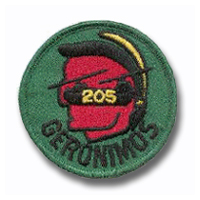 205th Aviation Company Patch 205th Aviation Company Patch |
||||||||||||||||||||||||||||||||||||||||||||||||||||||||||||||||||||||||||||||||||||||||||||||||||||||
| 1974 | ||||||||||||||||||||||||||||||||||||||||||||||||||||||||||||||||||||||||||||||||||||||||||||||||||||||
| (Source: STARS & STRIPES, Aug 1, 1974) | ||||||||||||||||||||||||||||||||||||||||||||||||||||||||||||||||||||||||||||||||||||||||||||||||||||||
| One of the CH-47 CHINOOK helicopters of the 205th Avn Co has been named after the City of Oberursel at a ceremony held at Camp King in Oberursel recently. Oberursel has had a long association with the German aircraft industry through the Oberursel aircraft plant. The plant is still in operation and manufactures engines for Bell helicopters used by the Bundeswehr. (Webmaster note: The plant was occupied by the US Army after the end of WWII and served as an ordnance maintenance facility for several years before being returned by the US Army to the original owners. For more see the 85th Ordnance Battalion Page.) |
||||||||||||||||||||||||||||||||||||||||||||||||||||||||||||||||||||||||||||||||||||||||||||||||||||||
| 1978 | ||||||||||||||||||||||||||||||||||||||||||||||||||||||||||||||||||||||||||||||||||||||||||||||||||||||
| (Source: STARS & STRIPES, July 29, 1978) | ||||||||||||||||||||||||||||||||||||||||||||||||||||||||||||||||||||||||||||||||||||||||||||||||||||||
| The 205th Aviation Company is located at Finthen AAF (near Mainz) and falls under the control of the 4th Transportation Brigade. The company, commanded by Maj Arno Hoerle, has a strength of 230 military personnel including 43 officers. The 205th is equipped with 16 CH-47 CHINOOK cargo helicopters and two UH-1H HUEY utility helicopters. (There are two other CHINOOK companies in Europe at this time: 180th Avn Co, Schwaebisch Hall, and 295th Avn Co, Colman Barracks, Mannheim-Sandhofen. These two companies belong to the 11th Avn Gp.) The company's primary mission is to provide air transportation of sensitive cargo (including high-priority items to US embassies in Europe). Its secondary mission is to provide air transportation support to USAFE. These missions involve extensive international flights to countries such as Norway, England and Italy. (In another S&S article later in the year, the newspaper reported on an 3-day training mission in which a detachment of the 205th (with three CHINOOKS) supported the German 890th Pionier (Engineer) Battalion out of Zweibrücken. The 890th is responsible for 900 miles of the CEPS pipeline system. The 205th provided airlift of pipe sections, equipment and heavy pumps to various field sites.) |
||||||||||||||||||||||||||||||||||||||||||||||||||||||||||||||||||||||||||||||||||||||||||||||||||||||
Related Links: |
||||||||||||||||||||||||||||||||||||||||||||||||||||||||||||||||||||||||||||||||||||||||||||||||||||||
